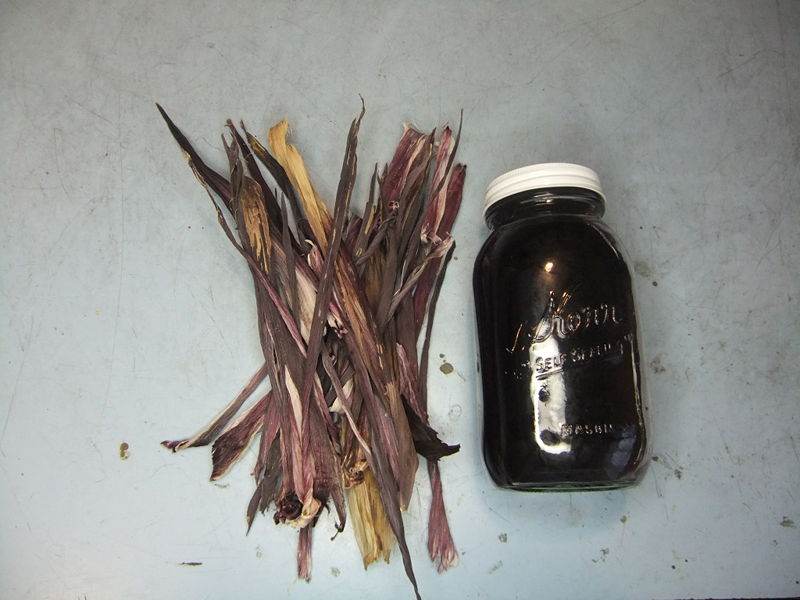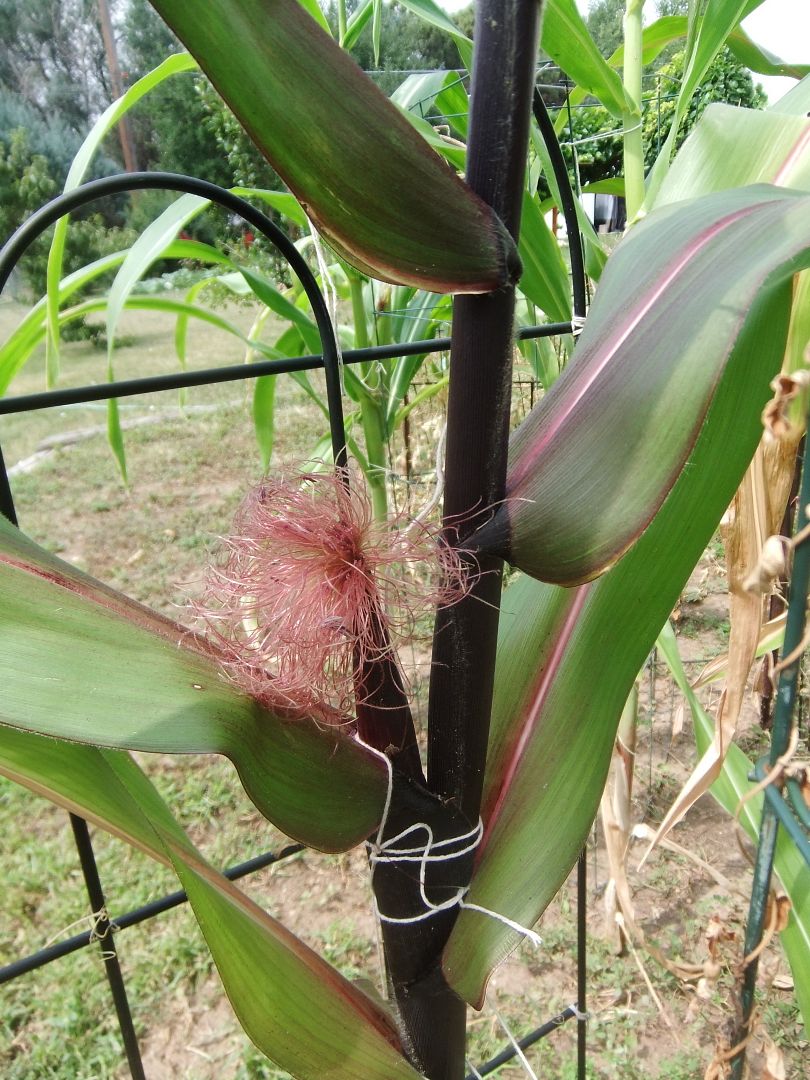
 2
2




Mostly I manage to connect with city gardeners and forage from park annual garden beds for when plants get pulled at end of season, and there are lots of annual plants for dyes to gather from! But I do have some woad growing, and this year we planted madder- I have been warned Madder is very vigorous and will take over, so will have to watch it I guess. In a shady area- under our bamboo and willow crops (for weaving) -we also planted sweet woodruff, again, I understand it can be aggressive, but it is in the same family as madder and apparently the roots will give a pink dye. I am ok if it takes over- it will be a nice change from the running buttercup which so far I can't find much of a purpose for! In my best case scenario- the sweet woodruff will take over from the buttercup, and in trying to weed that I at least am gathering plants for dye. My current favourite dye is the bark from the Paulownia tomentosa tree- known as the empress or princess or foxglove tree. It is invasive in the southern states, but not this far north where we grow it as an ornamental. My husband pollards several each year, and makes musical wooden horns with it. He carves the bark off for curing the wood, and I use the bark for dye. On wools I get rich chestnut browns, soft golden browns or pinks from exhaust baths and deep rosy pinks on my linen crops. I like a versatile dye plant!
"We're all just walking each other home." -Ram Dass
"Be a lamp, or a lifeboat, or a ladder."-Rumi
"It's all one song!" -Neil Young
 2
2




Judith Browning wrote:My two year old madder is blooming....the flowers are really tiny.
the second picture is, I am pretty sure yellow senna...leila H. if you notice this maybe you can ID, it is from your seed, I think:)
 2
2




Practice being a Maker without first being a Consumer whenever possible...
 2
2




Sharon Kallis wrote:Leila, Don't beat yourself up for not doing the EVERYTHING!! I fall into that trap every once in a while, and have to remind myself that I am playing the "long game" . I might get half of what I want done in a season- if I am lucky- I ALWAYS bite off more then I can chew in a garden season, and then run around like a crazy woman for 5 months having no life at all other then garden/project related tasks... then settle in in the fall to more fibre stuff! It is hard work being the queen of everything in our little fiefdoms, but eventually it all gets done- or close enough!
I admit to adopting a "good enough"principal now with many things- good enough weeding, good enough house cleaning, good enough dog-parenting, good enough event planning for harvest or garden celebrations- it is just never going to be perfect, and I live with that more comfortably now.
I try and give myself goals like- gather enough dye plants from foraging dog walks for a bunch of winter dye projects. OR- Get enough spinning done that I can take on one big knitting project a year. Keep myself in a steady diet of kale from what the garden produces while I am just barely paying attention. The long game is about realizing that eventually all those little bits of gathering add up to something, those few minutes spinning here and there do produce enough knitting fodder to keep the needles clacking in the cold dark months... There is certainly a seasonal rhythm to all the work isn't there?
And if you can divide and conquer with friends- all the better!
This was my second year of growing flax for linen as a community project, there were more of us involved this year- and many hands do make lighter work for sure- we just talked today about trying as a small group to grow some indigo next season- so knowing I have a team to work with makes it less daunting for the weeding and watering involved- we are going to try some Ramie as well- just cause- might as well see what that is like as a crop, ever tried it?
 4
4




Practice being a Maker without first being a Consumer whenever possible...
 3
3




 3
3




Practice being a Maker without first being a Consumer whenever possible...
 2
2




 You would not believe the number of times I have tried to knit and given up. Once I found what must have been someone's entire collection of needles....all sizes and types and I decided that that was a sign and that this time I would learn to knit and be good at it...........I have since passed them on to my friend the bobbin lace maker and I have bought new some large ones and then another time another size and once I found a free video............I know how to do the basic knit and purl but somehow I can't work up any speed or ease in the process like I have with crochet and I needed it to get to the mindless 'don't have to think about what I am doing' stage.
You would not believe the number of times I have tried to knit and given up. Once I found what must have been someone's entire collection of needles....all sizes and types and I decided that that was a sign and that this time I would learn to knit and be good at it...........I have since passed them on to my friend the bobbin lace maker and I have bought new some large ones and then another time another size and once I found a free video............I know how to do the basic knit and purl but somehow I can't work up any speed or ease in the process like I have with crochet and I needed it to get to the mindless 'don't have to think about what I am doing' stage.
"We're all just walking each other home." -Ram Dass
"Be a lamp, or a lifeboat, or a ladder."-Rumi
"It's all one song!" -Neil Young
 2
2




 2
2




"We're all just walking each other home." -Ram Dass
"Be a lamp, or a lifeboat, or a ladder."-Rumi
"It's all one song!" -Neil Young
 1
1




"We're all just walking each other home." -Ram Dass
"Be a lamp, or a lifeboat, or a ladder."-Rumi
"It's all one song!" -Neil Young
 3
3




Judith Browning wrote:I've got way too much woad seed....can send a bit in an envelope if anyone would like to try it...any larger amounts I would need shipping $$.
I think it is considered an invasive weed in some states so check first...that has never been a problem here...i don't know if i have ever had it volunteer...I always start it carefully from seed in a flat and transplant before the roots get too big. It is one of those seeds that needs to be just pressed into the surface of moist soil and barely covered...I keep the soil moist until it germinates.
Projects, plans, resources - now on the Permies.com digital marketplace.
Try the Everything Combo as a reference guide.
 1
1




Potassium aluminum sulfate bonds with the dyestuff and makes an insoluble lake INSIDE the fiber. Without this insoluble bond, the dye can wash out. This is why we don’t put dye, alum, and fiber in the same pot; inevitably some of the dye will bind with the alum in the bath OUTSIDE the fiber. That would be a waste of our dye and mordant.


"We're all just walking each other home." -Ram Dass
"Be a lamp, or a lifeboat, or a ladder."-Rumi
"It's all one song!" -Neil Young
 4
4




Never give up, Never give up, Never give up!!!
 2
2





"We're all just walking each other home." -Ram Dass
"Be a lamp, or a lifeboat, or a ladder."-Rumi
"It's all one song!" -Neil Young
 2
2




 2
2




 2
2




 2
2




 2
2




 3
3











 1
1




...24 plants give enough flowers to dye one pound of wool or silk ...
..Preparing Dye Bath
amount of flowers should be pound for pound with amount of yarn
soak the flowers in hot water for 24 hours
simmer for 1 hour, cool
strain out the flowers
Dye the Yarn
add the wet, mordanted wool to the dye bath, add more water if necessary. Yarn should be covered with water. Bring to simmer.
simmer for 1 hour, let yarn cool in the dye bath
rinse and SURPRISE! you are never sure of exactly what colour you will get, but it will be some lovely yellow....







 2
2




"We're all just walking each other home." -Ram Dass
"Be a lamp, or a lifeboat, or a ladder."-Rumi
"It's all one song!" -Neil Young
 2
2




 2
2











 3
3




Practice being a Maker without first being a Consumer whenever possible...
 4
4




Practice being a Maker without first being a Consumer whenever possible...
 1
1




Sharon Kallis wrote:I just went to an artists talk yesterday and am very inspired by this womans work! Anna Haywood-Jones has done a beautiful job of rigidly weaving samplers of 5 different fibres- linen, cotton, rayon, silk and wool each prepped for the dye bath in 3 ways~ no mordant, alum and ferrous. She did her warp and weft in repeating patterns with all of these and then pipped the sampler in the dye bath... The project was done in Nova Scotia, travelling around the province and noting the location plant species and date. The website is a fantastic resource and very inspiring! Google Anna Haywood-Jones tinctoria cartographies.

"We're all just walking each other home." -Ram Dass
"Be a lamp, or a lifeboat, or a ladder."-Rumi
"It's all one song!" -Neil Young
 2
2




Practice being a Maker without first being a Consumer whenever possible...
 1
1











 1
1











 4
4







 3
3











 1
1




Working and living in Shetland brings inspiration for creativity. The sea and landscape provide an ever changing palette of colour. Walking, watching and being in the Isles means existing close to nature in all her elemental aspects. The plants that survive the diverse climate never cease to amaze. Discovering the colours that they can dye wool feels magical. The sheep that live here are hardy animals and grow thick fleece that spins, felts and dyes well.


"We're all just walking each other home." -Ram Dass
"Be a lamp, or a lifeboat, or a ladder."-Rumi
"It's all one song!" -Neil Young





"We're all just walking each other home." -Ram Dass
"Be a lamp, or a lifeboat, or a ladder."-Rumi
"It's all one song!" -Neil Young
 3
3









|
Shake it tiny ad! Shake it!
turnkey permaculture paradise for zero monies
https://permies.com/t/267198/turnkey-permaculture-paradise-monies
|







